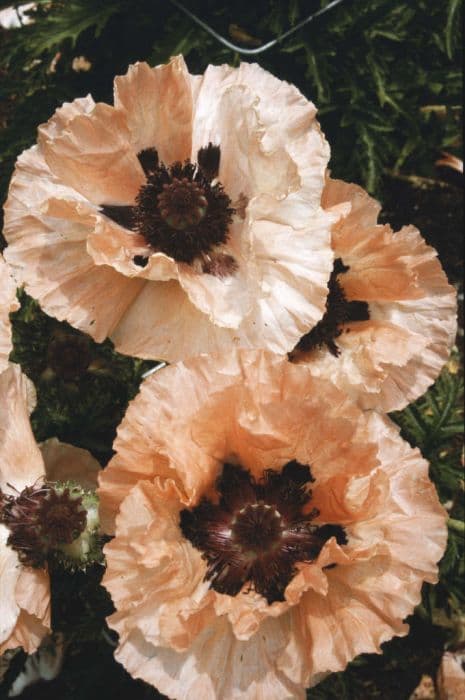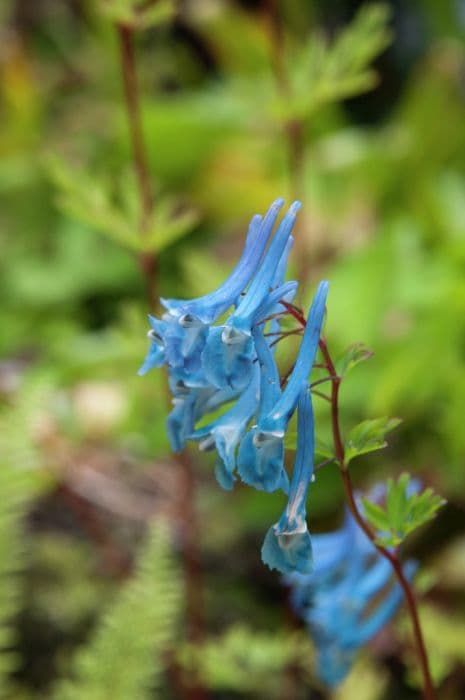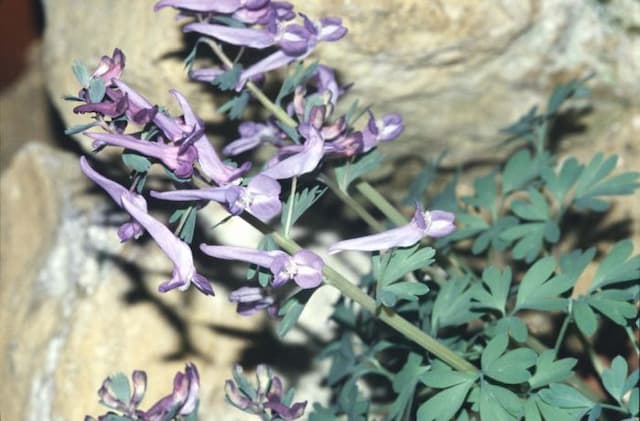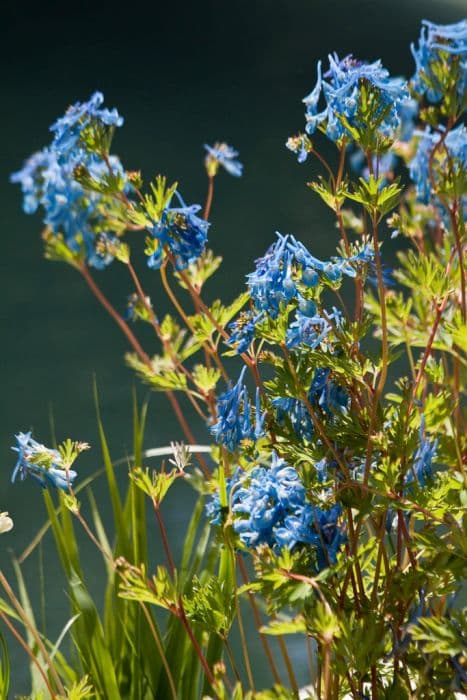Oriental Poppy Papaver (Oriental Group) 'Khedive' (d)

ABOUT
The plant known as the Oriental Poppy 'Khedive' displays a striking appearance, with large, showy blooms that are a prominent feature. The flowers of this plant boast a brilliant color, often a deep and vibrant hue that can range from rich pinks to reds. At the center of these flowers, you typically find a contrasting black or dark purple blotch, providing an eye-catching display that adds to the ornamental quality of the plant. The petals are delicate and silky, sometimes exhibiting a slightly ruffled or fringed edge that contributes to their lavish look. Each flower possesses a generous number of petals, which results in a full and lush appearance, giving off a sense of opulence and luxury. Below the blooms, the foliage forms a lush backdrop for the spectacular flowers. The leaves are deeply lobed and have a somewhat bristly texture, with a rich green color that remains throughout the growing season, completing the visual appeal of the plant. The leaves emerge early in the growing season and can provide a green, textural contrast to the garden even before the blooms appear. Overall, the Oriental Poppy 'Khedive' is a plant with a dramatic visual impact, known to draw the eye and serve as a focal point in a garden setting due to its stunning flowers and attractive foliage.
About this plant
 Names
NamesFamily
Papaveraceae.
Synonyms
Oriental Poppy, Garden Poppy.
Common names
Papaver orientale 'Khedive'
 Toxicity
ToxicityTo humans
The plant Papaver, commonly known as the Oriental poppy, has a certain level of toxicity to humans. While not typically lethal, ingestion of various parts of the Oriental poppy can still pose risks. Many poppies contain alkaloids such as morphine and codeine, which can cause symptoms ranging from mild sedation to respiratory depression if consumed in significant quantities. Symptoms might include nausea, vomiting, dizziness, and sedation. Consumption of large amounts of poppy parts should be avoided to prevent potential opioid-like effects and other adverse health outcomes.
To pets
The Oriental poppy is considered to have a mild to moderate level of toxicity to pets, such as dogs and cats. As with humans, the main concern is the presence of alkaloids that can cause sedation or more serious symptoms if ingested in large amounts. Signs of Oriental poppy poisoning in pets may include lethargy, loss of appetite, coordination problems, and potentially depression of the central nervous system. Pet owners should be cautious and keep these plants out of reach to avoid accidental ingestion and the issues that could follow.
 Characteristics
CharacteristicsLife cycle
Perennials
Foliage type
Deciduous
Color of leaves
Green
Flower color
Orange
Height
2-3 feet (60-90 cm)
Spread
1-2 feet (30-60 cm)
Plant type
Herb
Hardiness zones
3-7
Native area
Asia
Benefits
 General Benefits
General Benefits- Attractive Flowers: The plant produces striking blooms that enhance garden aesthetics.
- Pollinator Friendly: Attracts bees and butterflies, supporting local ecosystems.
- Low Maintenance: Requires minimal care once established, ideal for busy gardeners.
- Drought Tolerance: Able to withstand periods of low water availability after establishment.
- Cold Hardy: Can survive in cooler climates, making it suitable for a range of gardens.
- Seasonal Interest: Adds vibrant color to gardens in the blooming season, typically late spring or early summer.
- Mixed Borders: Works well in mixed flower borders due to its height and structure.
- Cottage Garden Style: Ideal for creating or enhancing a cottage garden look.
 Medical Properties
Medical PropertiesThis plant is not used for medical purposes.
 Air-purifying Qualities
Air-purifying QualitiesThis plant is not specifically known for air purifying qualities.
 Other Uses
Other Uses- The large, showy flowers of the Oriental poppy can be used in flower arrangements to add a bold pop of color. Their unique texture and size make them a dramatic centerpiece.
- Oriental poppy petals are sometimes used for coloring in cosmetics and fabrics, giving a natural and subtle tint to the products.
- The seeds of Oriental poppies can be added to bird feed mixtures, providing a nutritious snack for feathered garden visitors.
- Dried Oriental poppy seed pods are often used in craft projects or dried flower arrangements for their interesting shapes and textures.
- The Oriental poppy's striking appearance makes it a popular choice for botanical illustration and garden-themed art.
- Photographers sometimes use Oriental poppies as subjects to practice macro photography techniques due to their intricate details.
- The plant can function as a natural dye for textiles, offering hues ranging from light ivory to deep orange, depending on the part of the plant used.
- Gardeners sometimes create poppy-themed gardens, using Oriental poppies as a focal point because of their bright colors and large blooms.
- As a way to teach children about the lifecycle of plants, Oriental poppies can be used to demonstrate seed germination, growth, and flowering.
- The sap from Oriental poppy stems has been historically used as a color fastener for inks in some traditional practices.
Interesting Facts
 Feng Shui
Feng ShuiThe Oriental poppy is not used in Feng Shui practice.
 Zodiac Sign Compitability
Zodiac Sign CompitabilityThe Oriental poppy is not used in astrology practice.
 Plant Symbolism
Plant Symbolism- Peace: Papaver, also known as the poppy, is often associated with peace, especially after conflict, as they were commonly seen on battlefields after war.
- Remembrance: Poppies are a symbol of remembrance, particularly for soldiers who have died during wartime, as immortalized by the poem "In Flanders Fields."
- Rest: Because of the poppy's connection to opium, it can symbolize sleep, rest, and recovery.
- Beauty: The Oriental poppy, with its large and colorful blooms, is frequently associated with beauty in the plant world.
- Resilience: Poppies are known for their ability to grow in disturbed soil, symbolizing resilience and the ability to recover from adversity.
 Water
WaterThe Oriental poppy 'Khedive' should be watered deeply once a week, allowing for about 1 inch of water to soak the soil, which equates to about 0.5 gallons per plant for medium-sized poppies. During hotter, dry periods, increase the frequency to twice a week. It's important not to over-water as Oriental poppies prefer a well-draining soil and can be prone to rot if kept too moist. Water at the base of the plant to avoid wetting the foliage, as this can lead to fungal diseases. Reduce watering once the plant goes dormant after flowering to prevent excessive moisture around the root zone.
 Light
LightOriental poppy 'Khedive' thrives in full sun, meaning it should receive at least 6 to 8 hours of direct sunlight daily. Less intense morning sun is preferable to the harsh afternoon sun, but the plant will still perform well as long as the light is bright. Avoid deep shade areas, as this will inhibit the poppy's abundant flowering and can lead to leggy growth.
 Temperature
TemperatureOriental poppy 'Khedive' can survive in temperatures as low as 20°F in the winter and as high as 90°F in the summer. However, the plant prefers cooler temperatures, thriving in a range from 50°F to 75°F. Excessive heat can lead to stress, especially during blooming periods, so granting some afternoon shade in extremely hot climates can be beneficial.
 Pruning
PruningPruning Oriental poppy 'Khedive' involves deadheading spent flowers to encourage further blooming and to maintain a tidy appearance. After blooming, cut back the foliage once it turns yellow and begins to die back, usually in midsummer. This can be done annually, and it will help prevent self-seeding if not desired. Pruning is also necessary to remove any damaged or diseased tissue to prevent the spread of pests and diseases.
 Cleaning
CleaningAs needed
 Soil
SoilOriental Poppy 'Khedive' grows best in well-draining soil amended with compost. A soil pH of 5.5 to 7.0 is optimal. Sand or gritty material can be added to improve drainage. Mulching helps maintain consistent soil moisture.
 Repotting
RepottingOriental Poppy 'Khedive' does not require frequent repotting as it is a perennial plant. Repotting is usually only necessary if the plant outgrows its current space.
 Humidity & Misting
Humidity & MistingOriental Poppy 'Khedive' is tolerant of a wide range of humidity levels and does well in typical outdoor environments where extremes are avoided.
 Suitable locations
Suitable locationsIndoor
Provide full sun, well-draining soil, and infrequent watering.
Outdoor
Full sun, well-drained soil; water deeply but infrequently.
Hardiness zone
3-7 USDA
 Life cycle
Life cycleOriental Poppy 'Khedive' begins its life cycle as a seed, which, once sown, germinates in favorable conditions of soil, temperature, and light. The seedlings emerge, developing into a rosette of leaves at ground level in their first growing season. With favorable conditions and care, the plant enters its vegetative phase, growing taller and producing more leaves, and in the right climate, it might have a dormancy period during high summer heat. The following spring, the Oriental Poppy 'Khedive' matures and reaches its flowering stage, showcasing large, showy blooms in vibrant colors that attract pollinators. After flowering, the plant sets seed in distinctive seed pods that, once dried, release the seeds for new generation growth. Eventually, the plant completes its lifecycle by dying back after seed dispersal, usually undergoing a period of dormancy until the next growth cycle begins in the cooler weather.
 Propogation
PropogationPropogation time
Spring
Propogation: The Oriental Poppy 'Khedive' is typically propagated through division, a method best performed in late summer after the plant has finished flowering and has gone dormant. To propagate by division, carefully lift the clump of poppy plants from the ground, ensuring to maintain as much of the root system as possible. Using a sharp, clean knife or spade, divide the clump into smaller sections, each with several growth buds or eyes. Replant the divisions immediately at the same soil depth they were previously grown, spacing them about 12 to 18 inches (30 to 45 centimeters) apart to allow enough room for growth. Water the new divisions well to help establish them. This method allows gardeners to create new plants that are genetically identical to the parent, ensuring the same desirable characteristics of 'Khedive'.









